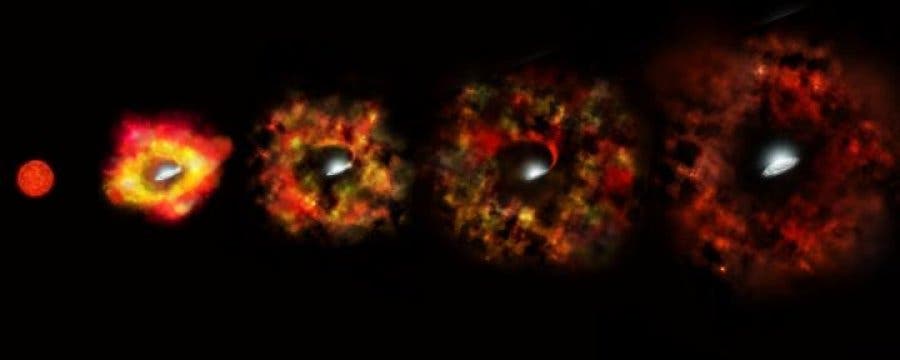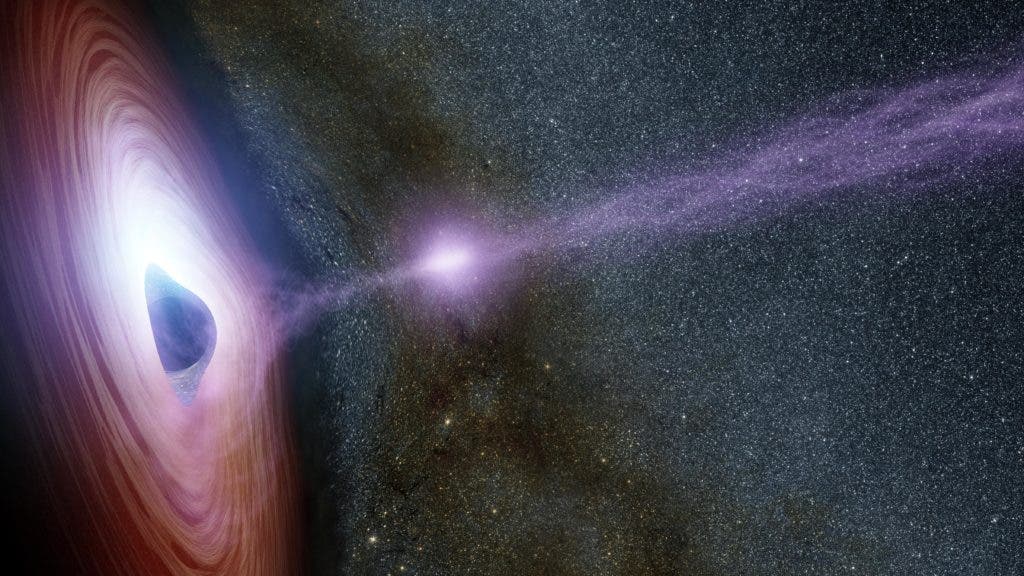Astronomers have, for the first time in history, witnessed a dying star going black hole. The surprising part? This momentous occasion wasn’t marked by a fiery supernova.

Image credits NASA.
The star of the show is/was N6946-BH1, a massive stellar body some 25 times our own sun. It used to reside some 22 million light years away in the NGC 6946 galaxy or “Fireworks Galaxy”, so named for its spectacular and frequent bouts of supernova activity. Starting in 2009, N6946-BH1 began to brighten slightly and by 2005 it seemed to have disappeared altogether.
To find out what happened to the star, a team of researchers led by Christopher Kochanek, professor of astronomy at The Ohio State University and the Ohio Eminent Scholar in Observational Cosmology, pointed the business end of the Large Binocular Telescope (LBT) at NGC 6946, to pick up on any infrared radiation emanating from the star. They didn’t find the star — rather, they were surprised to see a black hole had silently popped into existence after NGC 6946 fizzled out.
Going out without a bang
Kochanek leads a team of astronomers who have been spent the last 7 years poking around space with the LBT looking for “core collapses of massive stars that form black holes without luminous” novae, but this is the first one they’ve identified.
After NGC 6946 went extinct, they trained the Hubble Space Telescope’s gaze towards it location to see if it merely dimmed below visible levels, and the Spitzer Space Telescope to see if there’s any infrared radiation going off from that point — which would have been a sign that the star was obscured by a dust or think gas cloud.
All readings all came out negative, so for all intents and purposes, the instruments reported that there wasn’t any star in where N6946-BH1 used to be. Through a process of elimination, the team eventually concluded that the star had collapsed into a black hole under our noses.
We don’t exactly know how this transition could take place without a supernova also taking place. So we don’t know how often it happens either, but Scott Adams, first author and a former Ohio State student who earned his Ph.D. with the paper, was able to make a preliminary estimate.
“N6946-BH1 is the only likely failed supernova that we found in the first seven years of our survey. During this period, six normal supernovae have occurred within the galaxies we’ve been monitoring, suggesting that 10 to 30 percent of massive stars die as failed supernovae,” he said.
Sure, it’s a rough estimate, but until we can spot more black holes forming this way it’s a good guideline.
Stealth babies

Artist’s depiction of a supermassive black hole and its corona. Image credits NASA / JPL-Caltech.
These nova-less black holes are the result of what the team wanted to uncover in the first place. They set out to understand how massive black holes — of the kind the LIGO experiment detected via gravitational waves — could form in the wake of supernovas.
See, when you think about it, supernovas are a very inefficient, almost counterintuitive way of forming a black hole. During a supernova, a star will blow away much of its outer layers and a significant slice of its mass — and the bigger the star, the more mass it ejects. So you’d need a truly fat star, on the top ends of the red supergiant scale, to supply the ludicrous quantities of matter needed for a supernova and still have enough left over for a massive black hole of the kind LIGO picked up on.
But there’s a pointed lack of “high-mass red supergiants SN progenitors”, the authors note, meaning we don’t really see any black holes forming after these stars blow up. Witnessing this silent birth could help explain why supernovae are rarely seen in those stars, Kochanek said, while still explaining why there are so many big black holes around. The team estimates that up to 30% of such stars could quietly collapse into black holes without any supernova taking place.
“The typical view is that a star can form a black hole only after it goes supernova,” Kochanek says.
“If a star can fall short of a supernova and still make a black hole, that would help to explain why we don’t see supernovae from the most massive stars.”
The team concludes that if N6946-BH1 is confirmed as a failed supernova, it would explain the lack of red supergiant-sired black holes, as well as how some of the more massive ones out there formed in the first place.
The full paper “The search for failed supernovae with the Large Binocular Telescope: constraints from 7 yr of data” has been published in the journal Monthly Notices of the Royal Astronomical Society.






